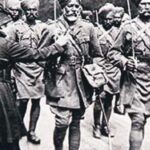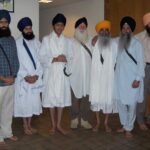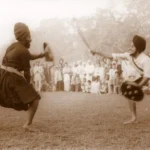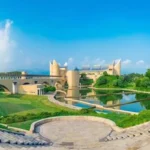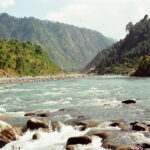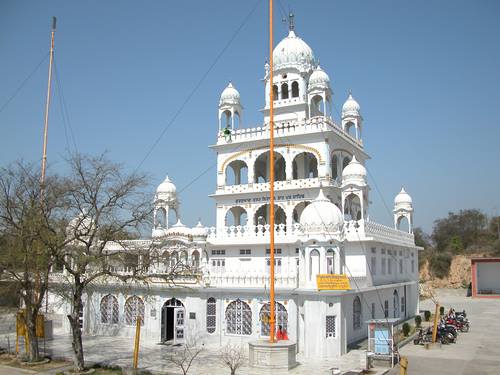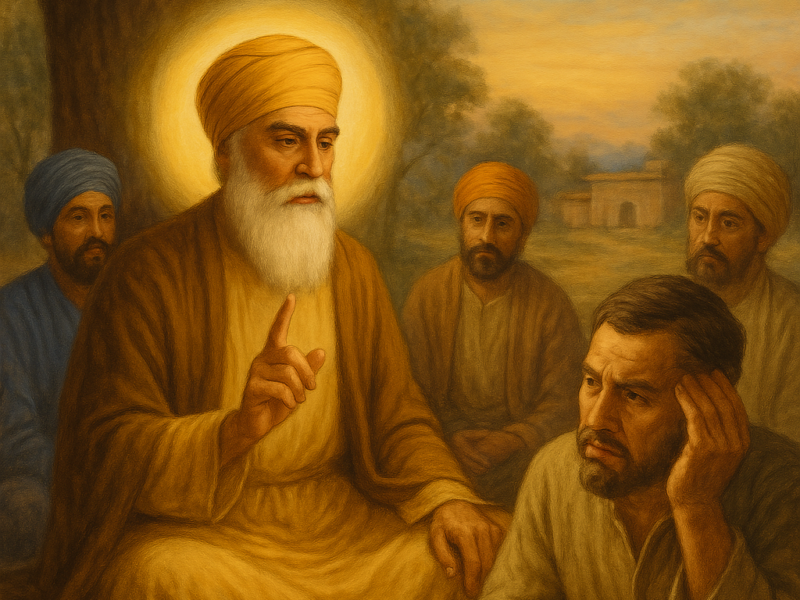Virasat-e-Khalsa is a Sikhism museum, located in the holy city, Anandpur Sahib, near Chandigarh, the capital of the Punjab region, India. The museum celebrates 500 years of Sikh history and 300 years of Khalsa’s birth, based on scriptures written by the tenth and last human grandmother, Guru Gobind Singh Ji. It works to attract tourists and pilgrims. This results in a dialogue between religion and a growing need in the construction industry. The other side promotes handicrafts in the local people and develops a sense of values, otherwise, it reminisces endlessly with the disruption of the volume of the atmosphere which is another phase of the visible challenge of Urbanism.
Structure
There are two buildings on each side of the gorge, connected by a ceremonial bridge:
The small western building includes an entrance plaza, a 400-seat auditorium, a two-story study and a reference library, and flexible exhibition galleries.
The east building has a circular monument and a wide, permanent exhibition space, combining two gallery collections trying to evoke the construction of regional castles (most visible in nearby Gurudwara) and create a stunning silhouette against the surrounding rock. place. The collection of galleries by five groups depicts the Five Virtues, the central tenant of Sikhism.
The buildings are constructed of localized concrete; some beams and columns remain open, though most buildings will be adorned with local honey-colored stone. The roof of the house is stainless steel and shows a double curve: it gathers and reflects the sky while a series of dams in the canyon creates pools that reflect all complexity at night.
Visitor numbers
Tourist numbers have broken records as the museum is known as the most visited museum in the Indian subcontinent. The one-day footprint on March 20th, 2019 was one of the most recorded in a museum in India.
More than 10 million people have visited since its inception 8 years ago
A rich artistic art of Sikh culture and religious history, `Virasat-e-Khalsa` is found in the holy city of Anandpur Sahib, the birthplace of the Khalsa. Built as the last of the wealthy `Khalsa` heritage, the museum reflects the history and culture of Punjab; the heritage complex was built to emphasize the eternal message of the 10 Sikh Gurus.
If you think that a Museum would not exist without things, think again! The amazing Virasat-e-Khalsa created by Amardeep Bahl is a miracle that has left you stunned and you have to keep going back to know more and more.
Architecture
Built on 100 hectares of Anandpur Sahib, 85 kilometers from Chandigarh, Viraat-e-Khalsa or Khalsa Heritage Center stands the site of the birthplace of Khalsa Panth, the modern Sikh religion. The second holy Sikh shrine, Takht Keshgarh Sahib, is here. At Takht Keshgarh Sahib, you can see real weapons and swords, but I will leave that post someday.
It was here in 1699, the day of Baisakhi, when the 10th Sikh guru, Guru Gobind Singh, founded the Khalsa Panth and baptized the ‘Panj Piaras’ (the first five baptized Sikhs known as Gugu’s beloved).
The Museum’s prayer-shaped architecture reveals the history of Sikhs and culture – unprecedented. The project consists of two main buildings, connected by a connecting ceremonial bridge. The canopy on this bridge is a strange inspection of buildings and is placed on the opposite side of the sun and does not give any shade.
The western area has a hall that seats 400 people. It has a large exhibition gallery and library (including a Music library), located in all journals, magazines, books, and Sikhism articles.
The Eastern complex has a northern wing also known as the floral structure. It has another section, called boat construction or treasure building.
The roof of the flower building is shaped like a five-leaf clover – depicting Panj Piaras of Guru Gobind Singh or perhaps five religious monuments. Each petal stores a gallery that traces the life history of all gurus from birth to salvation/execution. The petal at the highest point has information and exhibitions at Guru Granth Sahib.
Gallery shows
An inspiring experience begins at ‘Panj Pani’ — A Boat Builder with the world’s largest hand-painted portrait, built by none other than the magnificent Orijit Sen. A 360-degree wall painting depicting the past and present of Orijit Sen. Punjab, as seen in its towns and villages and towns. When you enter the gallery, it is pitch black, suddenly the sound of birds chirping and the blue light suddenly breaking. The scenic feeling and vision are hard to put into words and very informative. You can see that the room resembles a deep walled fountain (almost like a popup card) that starts at dawn, conveys a lot of love stories, Punjabi festivals, customs, activities, the Golden Temple of historical times, and ends at sunset – all as guests climb a steep central path. . The visuals are paired with Punjabi songs, and of course, you can find visitors on Sunday Bhangra-climbing ramp.
15th Century Punjab
There is also the image of the 15th-century Punjab, where under the rule of Lodi, segregation and superstition had taken over.
Journey
After this gallery, you are provided with an Audio Guide with language selection options. It is one of the default ones that will hear which gallery you are entering and start the guide! As you embark on your journey of entry, the typical Ik-Onkar takes over the reins, unveiling a spectacular crystal-clear installation!
The Origin of Sikhism
Topical carpets decorated the walls of this part of the building where weavers from Mirzapur were imprisoned. This exhibition, with special sounds, is found in a drum-like structure and the audio message highlights important principles of Sikhism.
So begins an exciting journey into the life of the first five Gurus through the five petals of a flower structure. The story begins with Guru Nanak Dev and ends with Guru Arjan Dev.
The first petal highlights the state of the times in which Guru Nanak Dev was born, tracing his life through a journey (dasi) made. The Kartarpur area is where he gives “Guruship” to Bhai Lehna, naming him Guru Angad.
Guru Ramdas-Guru Amardas walkway
The following galleries showcase the achievements of Guru Angad Dev and Guru Amardas. One of the galleries is divided into two parts, by re-baoli in the middle, to highlight Guru’s contribution. The use of shadow cartoons and Indian handicrafts abounds in all galleries.
Baoli
The growth of Sikhism and the Creation of Amritsar
The fourth-phase gallery contains exhibitions of Guru Ram Das donation, which includes the construction of the city of Ramdaspur, adding 11 rugs to the existing Gurbani and Lavan campuses. The city of Ramdaspur has been rebuilt with an embroidered panel.
Guru’s sacrifice and Khalsa construction
There is another gallery depicting the assassination of Guru Arjan Dev in the form of a statue on the plains. Tatti Tava (figuratively illustrated how Guru would feel the roasted heat alive)!
The assassination of Guru Arjan Dev
The leaves on the plaque cover the lives of Guru Hargobind, Guru Har Rai, Guru Harkrishan, Guru Teg Bahadur, Guru Gobind Singh, and Gurta Gaddi.
Guru Hargobind Gallery
While Guru Hargobind was working against the Sikhs in an uprising against injustice and violence, Guru Har Rai and Guru Harkrishan dedicated their lives to social change and humanitarian work.
The other two exhibitions are about the Supreme Sacrifice of Guru Tegh Bahadur and Guru Gobind Singh. There is a small hall where you live to take a brief look at the construction of the Khalsa Panth (narrated by Divya Dutta / Kabir Bedi) before moving on to the final gallery of the first phase of the Museum.
Guru Gobind Singh founded Khalsa in 1699 at Anandpur Sahib.
Birth of Khalsa
After the formation of Khalsa, years of struggle followed Guru Gobind Singh. With the loss of his family and army, he wiped out the Guru Granth Sahib, seeking refuge with God.
From here you go down to the lowest level, and on your way, you can read short quotes from Guru Granth. This is the second phase of the Museum which opened in November 2016. 13 galleries in this category follow the social and political development and religion of the Sikh community from the early 18th century to the present.
Excerpts from Guru Granth
Low-level galleries record the trials, tribulations, and conquests of the Khalsa from Banda Bahadur to colonial times. I liked this second episode.
Baba Banda Bahadur
The rule of the Khalsa under the command of Baba Banda Singh Bahadur lasted a short time when the community emerged as a force capable of shaping the foundations of the Mughal dynasty. It was a time when ordinary people gained their ownership over the land of Punjab. When news of the Sikh invasion reached Bahadur Shah, Mughal forces responded by attacking and persecuting the Sikhs. After an eight-month siege of Gurudas Nagal, full of attacks and attacks, Banda Bahadur and his companions were finally abducted and taken to Delhi.
Banda Bahadur Gallery
Shortly after Banda Bahadur’s death was marked by wars, attacks, and violent violence. The year 1765 marked the end of this long period of turmoil and genocide. When the Khalsa finally defeated Abdali and took control of Lahore, independent Sikh rulers began to appear in Punjab. This was a time of peace, prosperity, and prosperity in Punjab. Art and crafts gained support and the creative side of the Sikhs began to emerge. Prosperity was back, and its exhibit at the museum is nothing short of real.
Excerpt from Amritsar: An Active Village
Another important gallery in this category is dedicated to Misls. With the 12 Misls, the Sikhs became the real guardians and rulers of Punjab. Collectively, the misls eventually became known as the Dal Khalsa. Any Sikh warrior on horseback can join any of the 12 Misls. You can find automatic Sikh mannequins with costumes and weapons used by the Misls.
Against the English
There is a screen with a double panorama showing the ceremony of the inauguration of Maharaja Ranjit Singh and his court up to British time. There is a black curtain opening, and the two walls of this gallery become a screen so that the horse that walks on one wall, is followed by another!
Appointment of Maharaja Ranjit Singh and his Court
Martyr Bhagat Singh, Kartar Singh Sarabha, Master Tara Singh, and other Sikh political and religious leaders also found space in the galleries. Master Tara Singh remains immortal with a cartoon robot. This is an experience that needs to be put in but I could not hear the speech clearly because the crowd wanted to record a robot miracle!
Master Tara Singh’s robot: yes, she moves her hands, raises her eyes, and speaks!
The provinces of the nobles, the colonial times, and the Ghadr movement are well documented in the Museum, as is the case with the Partition.
But what struck me most were the newly separated ones. The exposure of Sikh Dynamism that transformed Punjab with its strength and determination is unparalleled and will leave you with goosebumps.
Colonial Times
The construction of Chandigarh as a new city and the people rebuilding their lives repeated the values of Sikhism – those related to hard work, coping, and support. This is what Punjab and the Punjabi community say: simple, dedicated, peaceable, and smiling people – even in the face of adversity. There is so much to learn from this Museum and to meditate on it, so be sure to set aside a day you will never forget.
PS: You will notice many visitors without shoes. This is because there is a deep sense of respect for religion. Please stop judging. Museums are a fun place for everyone, and there is no rule for fun!
When you go out, don’t forget to check out the amazing Museum Store!
It has a really good price and is well stocked too! You will love children’s books and some magnets.

